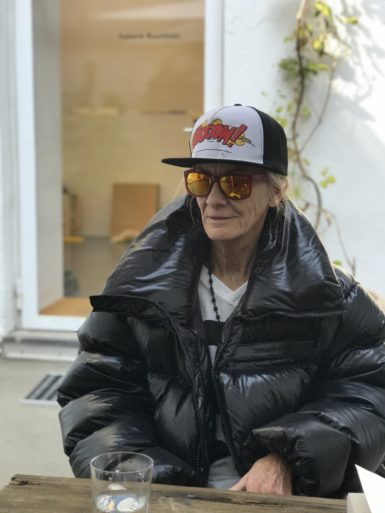[ad_1]

Bacher in 2018.
COURTESY GALERIE BUCHHOLZ/BERLIN/COLOGNE/NEW YORK
Because of the thrillingly multifarious nature of her art, and her general disinclination to explain it, Lutz Bacher has long been one of those rare artists who escape any single, easy summary. Such figures have to be discussed in anecdotes. There was the time when Bacher blanketed a gallery’s floor and courtyard with sand, the time she had illustrations from Playboy repainted, and the time she videotaped one of her dealers at work for months.
Over the course of more than 40 years, Bacher produced work in seemingly every medium, from scrappy collages to sprawling sculptures, all the while addressing—in modes that are poetic, wry, and bracingly direct—subjects like political terror, male-induced violence, the unfixed nature of identity, and the slipperiness of memory. She was, in other words, an essential artist for America at the present moment. Her death on Tuesday, of a heart attack in New York, ends one of the great, strange, original artistic runs of the past half-century.
Bacher—whose name is a pseudonym she adopted in the 1970s—was selective about the biographical information she shared, but certain facts are known. She was born in 1943, making her either 75 or 76. She was long based in Berkeley, California, and moved to New York in 2012. She was married for more than four decades to Donald C. Backer, a radio astronomer and professor, according to Galerie Buchholz, which represented her, and she is survived by her son, David A. Backer; her daughter-in-law, Una Grewal; her granddaughter, Annika Backer; her sister, Jo-Anna Lutz Jones; and her brother, Patrick B. Lutz.
Much has been made of Bacher’s elusiveness—the fugitive mystery she cultivated—but even when her art is enigmatic or restrained, it regularly centers on visceral matters like desire and danger, sadness and rage.
Her 1975 Men at War photographs derive from an image she found of sailors relaxing on a beach during the Vietnam War, reshot and cropped so as to draw out the intimacy and homoeroticism between young men who were trained to kill. The Lee Harvey Oswald Interview (1976) is a series of collages composed with photocopied pictures of the assassin and an interview she conducted with herself about him.
Copies and borrowings proliferate in Bacher’s work, often for the purpose of plumbing popular culture’s vulgarity and its dissolution of private space, both physical and psychic. Her “Jokes” series, which she began in 1987, pairs images of 1970s celebrities (Jane Fonda, Henry Kissinger) with ribald and menacing jokes, and in the 1990s, she commissioned commercial painters to make copies of pinup illustrations that Alberto Vargas made for Playboy. Her photo work Jackie and Me (1989) takes paparazzo Ron Galella’s stalker-ish photos of Jackie Kennedy Onassis in Central Park, and adds to them captions in his voice.
Bacher also approached her own immediate surroundings with a gimlet eye, and a focus on how history is written and recalled. Olympiad (1997) is a video tour of the 1936 Olympic Stadium in Berlin shot on aged tape, the image slipping in and out of legibility. From October 1997 to July 1998, she videotaped her dealer Pat Hearn at work in her Chelsea office, later editing some 1,200 hours of footage into a 40-minute piece that became a tribute to the storied gallerist when she died in 2000 at the age of 45.
While taking up au courant topics and techniques from appropriation and the critique of institutions to surveillance and the male gaze at various points in her career, Bacher could never be easily slipped into one category or movement. At the same time she was cribbing Vargas paintings, for instance, she was also making a work like Big Boy (1992), a cushy, blown-up version of the kind of anatomically correct doll that might be used to identify child abuse.
Unsurprisingly, such restless experimentation made Bacher something of an “artist’s artist” for much of her life. But her profile gradually grew, and the past decade saw a number of key outings, including exhibitions at MoMA PS1, in 2009; the Kunsthalle Zurich, the Institute of Contemporary Art, London, and Portikus in Frankfurt, in 2013; and Secession in Vienna in 2016, a show for which she placed huge, worn tubes across the floor.
In 2012, Bacher appeared in the Whitney Biennial, scattering hundreds of old baseballs across a space that had been used for a performance series—melancholy traces of movement and touch, of energy spent. A blank video projection shifted from black to white, accompanied by a snippet of the soundtrack from The Unbearable Lightness of Being (1988) as two lovers talk. “What are you thinking?” one says. The other replies, “I am thinking how happy I am.”
That piece remains one of the most beautiful artworks I have ever seen, a peculiar, delirious mixture of the specific and the abstract, the intimate (a couple in private) and the vast (all the action those balls were a part of). Bacher was a master of such surprising creations. In her hands, ingenious, spare ideas, executed with panache, yield outsized results.
A photo of military men, manipulated by Bacher, leads to an exegesis on camaraderie, war, and sexuality. Hours and hours of deadpan footage, distilled down, becomes a documentary portrait, a history, a memorial. And an adopted name, committed to over a lifetime, comes to represent a different way of being in the world.
[ad_2]
Source link

